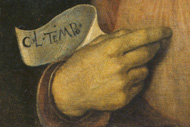„Col Tempo" The W. project
Péter Forgács’s installation / Curator: András Rényi
 Even people brought up according to universal humanistic values often notice themselves searching the features and clothes of their fellow travellers on the underground, guessing automatically which race the people belong to (arabic? gipsy? or our own race?) - in order to deduce from the type so as to trust the person or not. This kind of paranoid glance is conducted by visual stereotypes and ethnical or cultural prejudices, mostly unconsciously and blindly.
Even people brought up according to universal humanistic values often notice themselves searching the features and clothes of their fellow travellers on the underground, guessing automatically which race the people belong to (arabic? gipsy? or our own race?) - in order to deduce from the type so as to trust the person or not. This kind of paranoid glance is conducted by visual stereotypes and ethnical or cultural prejudices, mostly unconsciously and blindly.
On these occasions we are mostly blind to see ourselves while looking.
The title of our exhibition quotes Giorgene’s famous portrait of an old lady in Venice called La Vecchia, more precisely the inscription held in her hand, which, in the manner of great art, warns about the passing time, though in contemporary reading it can refer to the need of self-reflection of the looker, which needs its own time.
The exhibited material in Col tempio is based on the only and perhaps too banal motif of the human face and examines the arbitrary and dominant nature of the human vision of the Other and its capability of understanding itself. For the vision is never sheer acknowledgement of the seen, but an act of creating identity: adjustment or appropriation, identification or objectification. It can be devoted or careless, reserved or passionate, emotional or rational – but never innocent.
That is why, we believe, the human vision should reflect its own time and historicity: we must see with time, col tempo, we must see, how we look.
All the faces exhibited in the showrooms come from the archive established between 1939-1943 in Vienna by the Austrian anthropologist dr. Josef Wastl for scientific purposes. Peter Forgács decided to design this new total installation particularly for the Hungarian Pavilion of the Venice Biennale after two years of research in the archive. The photos and films taken for the purpose of anthropological diagnosis are standardized by the same structure of frontal and side sights and the movement between them. The vast collection of films and photos is supplemented by a number of masks made of cast.
The pictures of the prisoners of war, Jews before deportation, army officers and local civilians are staged in different ways: dependig on the pragmatical context they appear as individuals, as sample of species, as idols as caricatures or else.
The beholder is taken on a dramatised tour from the exaltation of the Other as a personality of its own (the heritage of European portrait art) through its objectivation as a single item in the huge database to the different ways of its manipulation and instrumentalization, whose main stages are to be seen on the attached DVD.
The different points of view are matched with different uses of time, space and size (for instance, some extremely slowed down and framed motion picture appear as in a portrait gallery facing the viewer individually, while a 3x6 meter huge video wall, symbolizing the ’archive’, presents 96 pictures moving at normal speed at the same time which has an overwhelming effect on the viewer)
The provisional names of the stages are as following: PORTAL – GALLERY – ARCHIVE – ATELIER – STATUS – TRAINING – ATRIUM – FAREWELL
The changing of these contradicting situations should make the viewer perplexed and confronts him/her with the blind automatisms of his/her way of looking. In case of not paying attention, the beholder unavoidably becomes an accomplice of the picture makers and part of the manipulation. He/she easily identifies him/herself with the seemingly unprejudiced way of scientific recording, which in the case of the Wastl-project led to the horrible destruction of those being recorded. Our exhibition avoids the direct thematization of these tragic consequences, because the context of the racial ideology of that time, of World War II and the Holocaust would easily distract the attention from the critic of the illusionistic innocence of our sight. This reflection is confirmed by the camera obsura-installation about techniques and protocols of anthropometric photography, just as well as the schematized video recordings of the actual beholder woven into the image-texture of the Wastl-archive.
The project entitled provisionally ”Col tempo” although it elaborates and documents mostly historic material, is not meant as a historic presentation: rather points at the social and antropoligical dimension of looking as a means of power and dominance. This can be opened up as a dramatic sensual experience for the beholder of the Venice Biennale only by confronting and combining the thorough study of contemporary everyday behaviour, remembrance of the past, heritage of European art history and contemporary art within one framework.
András Rényi, curator

